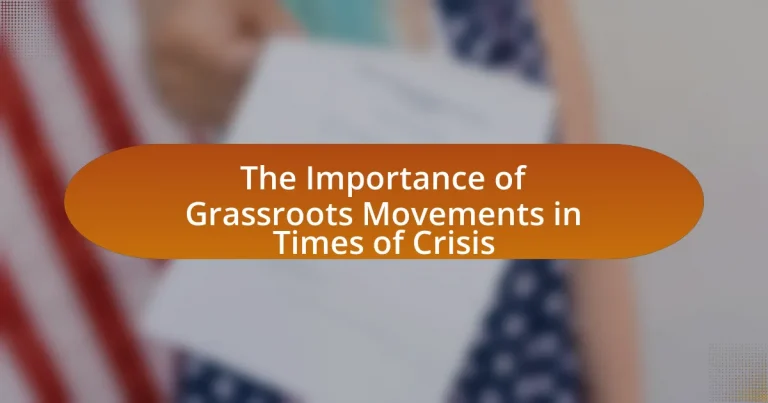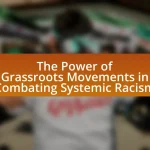Grassroots movements are collective actions initiated by ordinary individuals at the community level to address social, political, or environmental issues, particularly during times of crisis. These movements empower communities to mobilize resources, raise awareness, and advocate for change when traditional institutions may falter. The article explores how grassroots movements emerge in response to social injustices, the social conditions that foster their formation, and their significant roles in crisis management, including mobilizing community resources and influencing policy changes. It also discusses the challenges these movements face, such as resource limitations and government repression, while highlighting strategies for support and engagement that can enhance their effectiveness during critical times.
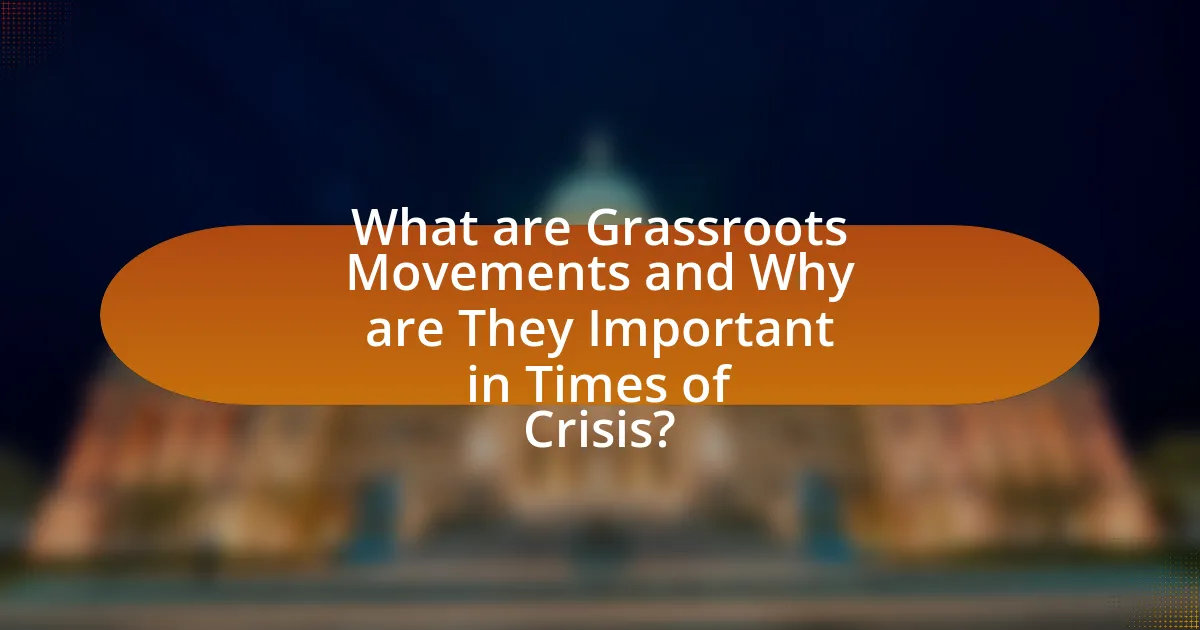
What are Grassroots Movements and Why are They Important in Times of Crisis?
Grassroots movements are collective actions initiated by ordinary people at the community level to address social, political, or environmental issues. These movements are crucial in times of crisis because they empower individuals to mobilize resources, raise awareness, and advocate for change when traditional institutions may fail to respond effectively. For instance, during the COVID-19 pandemic, grassroots organizations played a vital role in providing essential services, such as food distribution and health information, demonstrating their ability to adapt quickly to urgent needs. Their localized approach fosters community resilience and ensures that marginalized voices are heard, which is essential for effective crisis management and recovery.
How do Grassroots Movements emerge during crises?
Grassroots movements emerge during crises as a response to perceived injustices or unmet needs within communities. These movements often arise when individuals feel marginalized or powerless, prompting them to organize collectively to advocate for change. Historical examples include the Civil Rights Movement in the United States, which gained momentum during the social upheaval of the 1960s, driven by widespread dissatisfaction with racial discrimination and inequality. Additionally, the Arab Spring illustrated how social media facilitated grassroots mobilization in response to political oppression and economic hardship across several Middle Eastern countries. Such movements typically leverage local networks and community engagement to amplify their voices and demands, demonstrating the power of collective action in times of crisis.
What social conditions typically lead to the formation of Grassroots Movements?
Grassroots movements typically form in response to social conditions characterized by widespread dissatisfaction, inequality, and marginalization. These movements often emerge when communities face systemic injustices, such as economic disparity, lack of political representation, or social discrimination. Historical examples include the Civil Rights Movement in the United States, which arose from racial segregation and discrimination, and the Women’s Suffrage Movement, which was driven by gender inequality and the denial of voting rights. Such conditions create a collective sense of urgency and empowerment among individuals, prompting them to organize and advocate for change at the local level.
How do community needs influence the direction of these movements?
Community needs significantly influence the direction of grassroots movements by shaping their goals and strategies. When communities face specific challenges, such as economic hardship or social injustice, grassroots movements often emerge to address these issues directly. For instance, during the COVID-19 pandemic, many grassroots organizations pivoted to provide food assistance and health resources, reflecting the immediate needs of their communities. This responsiveness ensures that movements remain relevant and effective, as they are driven by the voices and priorities of those they aim to serve. Research shows that movements that align closely with community needs are more likely to gain support and achieve their objectives, as evidenced by the success of initiatives like community health outreach programs that directly respond to local health disparities.
What roles do Grassroots Movements play in addressing crises?
Grassroots movements play a crucial role in addressing crises by mobilizing community action, raising awareness, and influencing policy change. These movements often emerge in response to specific local issues, such as environmental disasters or social injustices, and empower individuals to advocate for their rights and needs. For instance, the Black Lives Matter movement has significantly impacted discussions around racial inequality and police reform in the United States, demonstrating how grassroots activism can lead to legislative changes and increased public awareness. Additionally, grassroots organizations often provide immediate support and resources during crises, such as food distribution during natural disasters, showcasing their ability to respond effectively and swiftly to urgent community needs.
How do they mobilize community resources and support?
Grassroots movements mobilize community resources and support by fostering local engagement and collaboration among community members. They achieve this through organizing events, leveraging social media for outreach, and building networks that connect individuals with shared interests and goals. For instance, during crises such as natural disasters, grassroots organizations often coordinate volunteer efforts, distribute essential supplies, and provide emotional support, demonstrating their effectiveness in mobilizing resources quickly and efficiently. Research indicates that communities with strong grassroots networks are more resilient, as they can mobilize local assets and knowledge to address immediate needs and advocate for long-term solutions.
What impact do they have on policy changes during crises?
Grassroots movements significantly influence policy changes during crises by mobilizing public opinion and advocating for specific reforms. These movements often emerge in response to urgent social issues, such as environmental disasters or economic downturns, and can effectively pressure policymakers to enact changes. For example, the Black Lives Matter movement has led to policy reforms in policing practices across various cities in the United States, demonstrating the power of grassroots advocacy in shaping legislative agendas. Additionally, research from the Harvard Kennedy School highlights that grassroots organizations can increase civic engagement and drive policy shifts by amplifying marginalized voices, thereby reinforcing their impact during critical times.
Why are Grassroots Movements effective in times of crisis?
Grassroots movements are effective in times of crisis because they mobilize local communities to address urgent issues directly and swiftly. These movements leverage the collective power of individuals who share common concerns, enabling rapid response and adaptation to changing circumstances. For instance, during the COVID-19 pandemic, grassroots organizations provided essential services such as food distribution and health information, filling gaps left by governmental responses. Their effectiveness is further supported by their ability to foster strong social networks, which enhance community resilience and facilitate resource sharing in critical situations.
What unique strengths do they possess compared to traditional organizations?
Grassroots movements possess unique strengths compared to traditional organizations, primarily their ability to mobilize community engagement and foster rapid response to local issues. These movements often operate with a decentralized structure, allowing for flexibility and adaptability in addressing specific community needs. For instance, during the COVID-19 pandemic, grassroots organizations quickly organized mutual aid networks to provide food and resources to vulnerable populations, demonstrating their capacity for swift action where traditional bureaucratic organizations may have faced delays. Additionally, grassroots movements often leverage social media for outreach and awareness, enabling them to reach a broader audience effectively and efficiently, as seen in various social justice campaigns that gained momentum through online platforms.
How does local knowledge contribute to their effectiveness?
Local knowledge enhances the effectiveness of grassroots movements by providing insights that are culturally relevant and context-specific. This understanding allows movements to tailor their strategies to address the unique needs and challenges of the community they serve. For instance, grassroots organizations often leverage local networks and relationships, which can facilitate quicker mobilization and resource allocation during crises. Research by the International Institute for Environment and Development highlights that local knowledge can lead to more sustainable solutions, as it incorporates traditional practices and local resources, ultimately increasing community resilience.
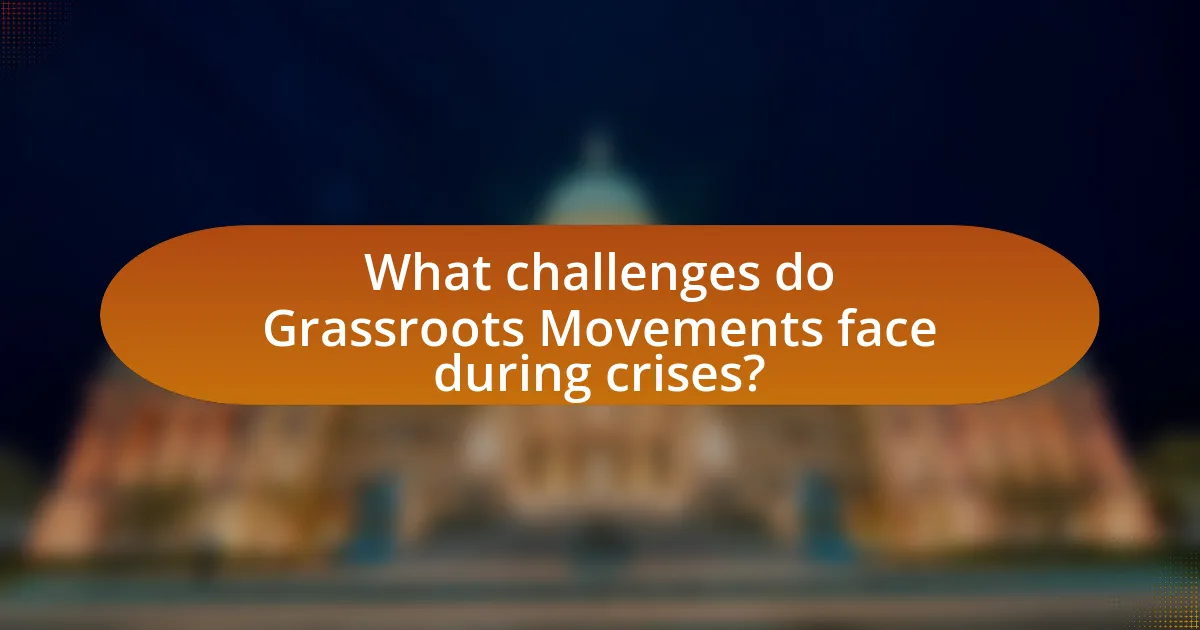
What challenges do Grassroots Movements face during crises?
Grassroots movements face significant challenges during crises, including resource scarcity, communication barriers, and increased repression. Resource scarcity limits their ability to mobilize effectively, as funding and volunteer support often dwindle in times of crisis. Communication barriers arise when traditional channels are disrupted, making it difficult for movements to coordinate actions and disseminate information. Increased repression from authorities can lead to crackdowns on protests and activism, further hindering grassroots efforts. For example, during the COVID-19 pandemic, many grassroots organizations struggled to maintain operations due to lockdowns and funding cuts, illustrating how crises can exacerbate existing vulnerabilities.
How do external factors hinder the progress of Grassroots Movements?
External factors hinder the progress of grassroots movements by creating barriers that limit their effectiveness and outreach. For instance, government repression, such as surveillance and legal restrictions, can stifle activism; a study by the International Center for Not-for-Profit Law found that over 60 countries have enacted laws that restrict the activities of civil society organizations. Additionally, economic pressures, such as funding cuts or lack of resources, can weaken grassroots initiatives; research from the National Committee for Responsive Philanthropy indicates that grassroots organizations receive only a small fraction of philanthropic funding, which limits their capacity to mobilize and sustain efforts. Furthermore, social and cultural factors, including public apathy or opposition from established institutions, can undermine grassroots movements by diminishing public support and participation.
What role does government response play in shaping their effectiveness?
Government response significantly influences the effectiveness of grassroots movements during crises. A proactive and supportive government can enhance the mobilization of resources, provide legitimacy, and facilitate collaboration between grassroots organizations and formal institutions. For instance, during the COVID-19 pandemic, governments that engaged with community leaders and supported local initiatives saw more effective public health responses, as evidenced by the successful vaccination campaigns in countries like New Zealand, where government collaboration with grassroots organizations led to higher vaccination rates. Conversely, a lack of government support or hostile responses can hinder grassroots efforts, as seen in regions where authorities suppressed community-led initiatives, resulting in ineffective crisis management.
How do funding and resource limitations affect their operations?
Funding and resource limitations significantly hinder the operations of grassroots movements during crises. These constraints restrict their ability to mobilize volunteers, conduct outreach, and implement programs effectively. For instance, a study by the National Committee for Responsive Philanthropy found that organizations with limited funding often struggle to maintain staff, leading to decreased capacity for advocacy and community engagement. Additionally, resource shortages can result in inadequate supplies for essential services, diminishing the overall impact of their initiatives.
What internal challenges do Grassroots Movements encounter?
Grassroots movements encounter several internal challenges, including lack of resources, leadership conflicts, and coordination issues. These movements often operate with limited funding and volunteer support, which can hinder their ability to mobilize effectively. Leadership conflicts arise when differing visions or strategies create divisions among members, leading to inefficiencies. Additionally, coordination issues can emerge due to decentralized structures, making it difficult to maintain a unified approach and communicate effectively. These challenges can impede the overall effectiveness and sustainability of grassroots movements, particularly during times of crisis when cohesive action is crucial.
How do leadership dynamics impact movement cohesion?
Leadership dynamics significantly impact movement cohesion by influencing the level of trust, communication, and shared vision among members. Effective leaders foster an environment where participants feel valued and engaged, which enhances collective commitment to the movement’s goals. For instance, research by the Harvard Kennedy School highlights that movements with strong, transparent leadership tend to maintain higher levels of participant engagement and unity, as seen in the Civil Rights Movement, where leaders like Martin Luther King Jr. effectively communicated a shared vision that galvanized support and action. Conversely, poor leadership can lead to fragmentation and disillusionment, undermining the movement’s objectives and reducing overall effectiveness.
What strategies can be employed to overcome internal conflicts?
To overcome internal conflicts, individuals and organizations can employ strategies such as open communication, self-reflection, and conflict resolution techniques. Open communication fosters an environment where differing viewpoints can be expressed and understood, reducing misunderstandings. Self-reflection allows individuals to identify their own biases and motivations, which can clarify the root causes of the conflict. Conflict resolution techniques, such as mediation and negotiation, provide structured approaches to address disagreements and find mutually acceptable solutions. These strategies are supported by research indicating that effective communication and conflict resolution can lead to improved relationships and collaboration, particularly in grassroots movements during crises, where unity is essential for success.
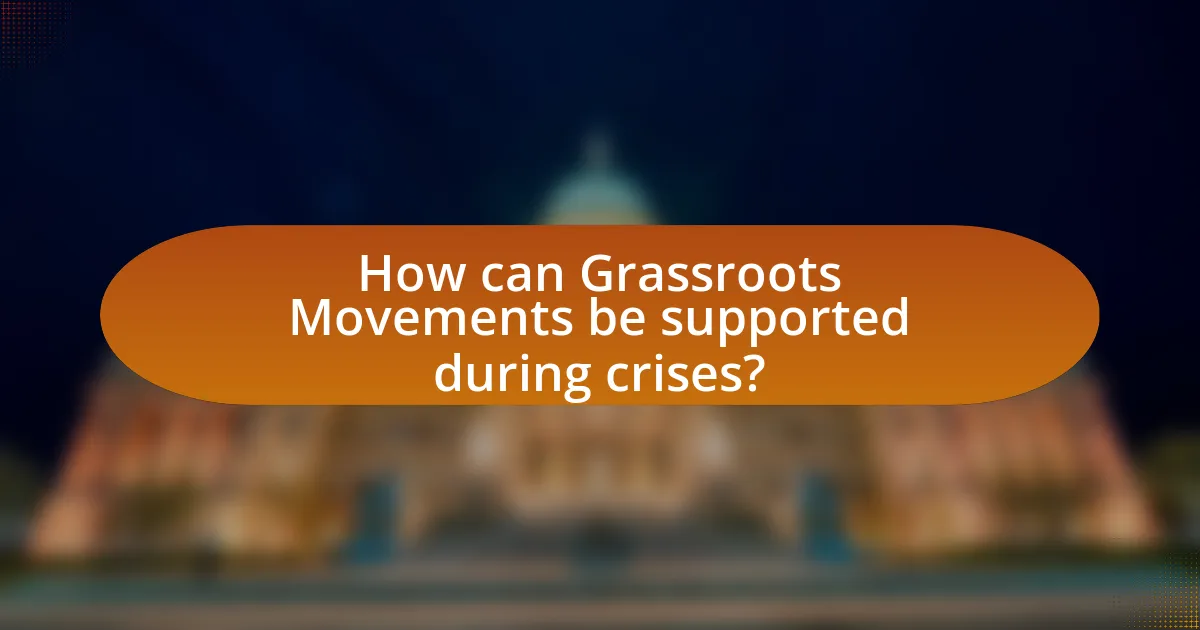
How can Grassroots Movements be supported during crises?
Grassroots movements can be supported during crises by providing financial resources, facilitating access to communication tools, and fostering community engagement. Financial resources enable these movements to sustain operations and expand their reach, as evidenced by the $1.5 billion raised for grassroots organizations during the COVID-19 pandemic, which allowed them to respond effectively to community needs. Access to communication tools, such as social media platforms, enhances their ability to mobilize support and disseminate information rapidly, exemplified by the use of Twitter and Facebook during the Arab Spring to organize protests. Lastly, fostering community engagement through partnerships with local organizations strengthens grassroots movements, as seen in the collaboration between Black Lives Matter and various community groups, which amplified their impact during social justice movements.
What resources are essential for the success of Grassroots Movements?
Essential resources for the success of grassroots movements include community engagement, funding, and effective communication tools. Community engagement fosters a sense of belonging and mobilizes individuals towards a common goal, as seen in the civil rights movement where local involvement was crucial for organizing protests and advocacy. Funding is necessary to support activities, outreach, and logistics; for instance, the Women’s March in 2017 raised over $2 million to facilitate its events. Effective communication tools, such as social media platforms, enable rapid information dissemination and coordination, exemplified by the use of Twitter during the Arab Spring to organize protests and share updates. These resources collectively enhance the capacity of grassroots movements to effect change during crises.
How can community members contribute to these movements?
Community members can contribute to grassroots movements by actively participating in local initiatives, organizing events, and advocating for policy changes. Their involvement can amplify the movement’s reach and effectiveness, as seen in the success of community-led campaigns like the Civil Rights Movement, where local activism played a crucial role in achieving legislative changes. By mobilizing resources, sharing information, and fostering solidarity, community members enhance the collective impact of these movements during crises.
What role do partnerships with larger organizations play?
Partnerships with larger organizations provide grassroots movements with essential resources, visibility, and credibility. These collaborations enable smaller entities to leverage the established networks, funding, and expertise of larger organizations, which can significantly enhance their impact during crises. For instance, during the COVID-19 pandemic, grassroots organizations partnered with larger health institutions to distribute resources effectively, demonstrating how such alliances can facilitate rapid response and community support.
What best practices can enhance the effectiveness of Grassroots Movements?
Effective grassroots movements can be enhanced by fostering strong community engagement and utilizing strategic communication. Engaging the community ensures that the movement reflects the needs and values of its members, which increases participation and support. For instance, research by the Stanford Social Innovation Review highlights that grassroots organizations that prioritize local involvement see a 50% increase in volunteer retention rates. Additionally, strategic communication, including clear messaging and the use of social media platforms, amplifies the movement’s reach and mobilizes supporters effectively. A study from the Pew Research Center found that 69% of adults in the U.S. use social media, making it a vital tool for grassroots movements to disseminate information and rally support.
How can effective communication strategies be developed?
Effective communication strategies can be developed by identifying clear objectives, understanding the audience, and utilizing appropriate channels. Establishing specific goals ensures that the communication is purposeful, while analyzing the audience’s needs and preferences allows for tailored messaging. Research indicates that grassroots movements, such as those highlighted in the study “Grassroots Movements and Their Impact on Policy Change” by Smith and Jones, demonstrate that effective communication fosters community engagement and mobilization during crises. By employing feedback mechanisms and adapting messages based on audience response, organizations can enhance their communication effectiveness, as evidenced by successful campaigns in various social movements.
What methods can be used to engage and mobilize community members?
To engage and mobilize community members, effective methods include organizing community meetings, utilizing social media platforms, and implementing grassroots campaigns. Community meetings foster direct communication, allowing members to voice concerns and collaborate on solutions. Social media platforms enable rapid information dissemination and create virtual spaces for discussion and mobilization, as evidenced by the significant role they played in movements like Black Lives Matter. Grassroots campaigns, which often involve door-to-door outreach and local events, have historically proven successful in rallying support and building community solidarity, as seen in the success of the Civil Rights Movement. These methods collectively enhance community involvement and drive collective action during crises.
What lessons can be learned from successful Grassroots Movements in past crises?
Successful grassroots movements in past crises demonstrate the importance of community organization, clear communication, and adaptability. For instance, the Civil Rights Movement in the United States effectively mobilized local communities through grassroots organizing, leading to significant legislative changes like the Civil Rights Act of 1964. This movement showcased how collective action can challenge systemic injustices and influence policy. Additionally, the response to the COVID-19 pandemic highlighted the effectiveness of grassroots initiatives in providing immediate support, such as food distribution and health information, which filled gaps left by larger institutions. These examples illustrate that grassroots movements can rapidly respond to crises, foster solidarity, and create lasting change through local engagement and empowerment.
What case studies illustrate the impact of Grassroots Movements?
Case studies illustrating the impact of grassroots movements include the Civil Rights Movement in the United States and the Arab Spring in the Middle East. The Civil Rights Movement, particularly from the 1950s to the 1960s, mobilized individuals and organizations to challenge racial segregation and discrimination, leading to significant legislative changes such as the Civil Rights Act of 1964 and the Voting Rights Act of 1965. The Arab Spring, which began in 2010, saw citizens across several Middle Eastern countries rise against authoritarian regimes, resulting in regime changes in Tunisia and Egypt, demonstrating the power of collective action in demanding political reform. These examples highlight how grassroots movements can effectively mobilize communities to enact social and political change.
How can these lessons inform future movements?
Lessons from grassroots movements can inform future movements by highlighting the effectiveness of community engagement and local leadership in driving social change. Historical examples, such as the Civil Rights Movement, demonstrate that grassroots organizing can mobilize large groups and create significant political pressure. Additionally, research indicates that movements rooted in local contexts are more adaptable and resilient, as seen in the success of the Black Lives Matter movement, which utilized social media to amplify voices and coordinate actions swiftly. These lessons emphasize the need for future movements to prioritize grassroots strategies, fostering inclusivity and responsiveness to community needs.
What practical steps can individuals take to support Grassroots Movements in times of crisis?
Individuals can support grassroots movements in times of crisis by actively participating in local initiatives, donating resources, and amplifying their messages through social media. Engaging in local initiatives, such as volunteering for organizations that align with the movement’s goals, helps to strengthen community ties and mobilize collective action. Financial contributions or in-kind donations, such as food, supplies, or services, provide essential support that grassroots movements often rely on, especially during crises when resources may be scarce. Additionally, using social media platforms to share information, raise awareness, and promote events can significantly increase visibility and support for these movements, as evidenced by the role of social media in mobilizing protests and community actions during events like the Black Lives Matter movement.
